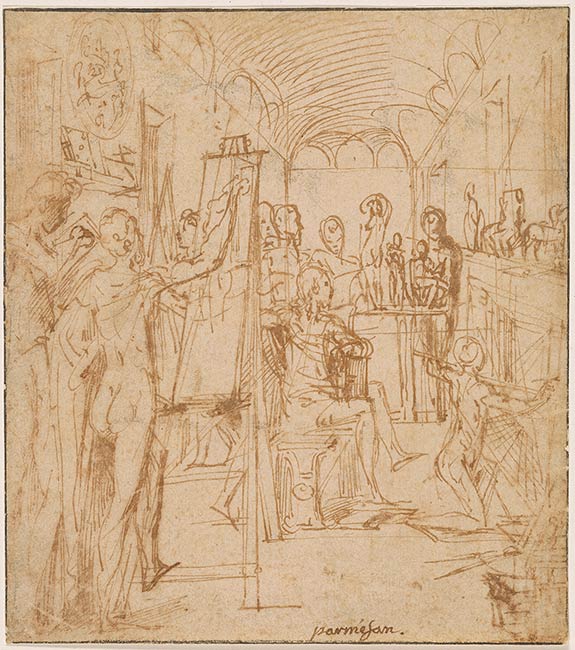
Among the more than nine hundred drawings by Parmigianino that survive are sheets consisting of preparatory studies for paintings, frescoes, and prints, in addition to erotica and scenes from everyday life sketched for his own pleasure. This lively drawing of an artist’s studio or an art academy would count among the latter. The spare and somewhat angular treatment of forms dates it to the last decade of Parmigianino’s career, and careful scrutiny is needed to read its details. The drawing depicts at left an artist at work before an easel, casually resting his left foot on a crossbar. Behind him, a second artist is studiously marking an opened notebook. At far right, a kneeling figure, a compass by his side, measures a series of orthogonals in a complex perspectival projection with a long ruler. The man sitting comfortably, almost regally, at center, hand resting on a book propped on his thigh, may be a patron of the arts or other nonartistic member of the academy. Scattered figures near the back of the vast, barrel-vaulted interior gaze admiringly at the creative agents and the sculptural models arrayed on a shelf and table. Books resting on a ledge below a coat of arms with a lion or griffin surmounted by a princely crown complete this picture of erudite learning. As was common during the Renaissance for the early stages of the development of a composition, the figures were conceived in the nude. They would have been shown draped once their final poses were determined if this were in fact a preparatory study for a painting or print.
Three studies by Parmigianino treat subjects closely related to the present drawing. One of these, in Besançon, of roughly the same size, similarly shows artists and onlookers in a monumental vaulted interior.1 One figure works on a painting, which partially mirrors the architecture of the setting, while a second constructs a nude on what appears to be a piece of paper placed on the floor. Furthermore, there exist two studies of a Nude Man Drawing at an Easel, Holding a Cornucopia that may depict allegories of painting.2
Clearly, the Morgan drawing is not an actual artist’s workshop but rather an ideal of creation and learning derived from the concept of an academy in the Platonic sense, as remarkably depicted in Raphael’s School of Athens in the Vatican.3 During the first half of the sixteenth century, the re-creation of Platonic academies was much in vogue; in 1539 Cosimo I de’ Medici founded the Academy in Florence, and many other cities followed suit. Often conceived as teaching establishments for artists, academies organized discussions on the theory and practice of art but also provided the setting for the sketching of antiquities and plaster casts. At the same time, artists’ studios evolved from artisanal medieval workshops to public spaces where a patron might sit for a portrait or a client could examine existing works and commission new ones.4 An engraving by Enea Vico after Baccio Bandinelli, known as the Academy of Baccio Bandinelli, could be considered a sculptor’s counterpart to the association of painters and draftsmen sketched by Parmigianino in the Morgan sheet.5 The engraving shows a spacious hall, an honorific emblem above a magnificent fireplace, and scattered books and statuettes, as well as onlookers and studious pupils reading and sketching by candlelight. An engraving of 1531 by Agostino Veneziano also portrays a group of sculptors drawing and discussing a small statue in Bandinelli’s studio.6 Though Vico, too, was a native of Parma and worked after drawings by Parmigianino as well as Bandinelli, the three images may well be visual manifestations of the studio’s new, prominent role rather than a reflection of a direct knowledge of each other’s art.
—REP
Footnotes:
- Musée des Beaux-Arts, Besançon, inv. 2346. See Popham 1971, 1: no. 22.
- Sotheby’s, London, 4 July 1988, lots 9 and 10; see Ekserdjian 1999, nos. 53–54.
- For the revival of the term academy, see Pevsner 1940, chapters 1 and 2.
- Cole and Pardo 2005, passim.
- Bartsch 30: no. 49. Roger Ward dates the engraving on grounds of style to the first half of the 1540s. See Pevsner 1940, 40.
- Bartsch 27: no. 418; see Pevsner 1940, 39–40.
Watermark: none.
Inscribed at lower right, in pen and brown ink, "parmesan".
Lawrence, Thomas, Sir, 1769-1830, former owner.
Murray, Charles Fairfax, 1849-1919, former owner.
Morgan, J. Pierpont (John Pierpont), 1837-1913, former owner.
Morgan, J. P. (John Pierpont), 1867-1943, former owner.
Rhoda Eitel-Porter and and John Marciari, Italian Renaissance Drawings at the Morgan Library & Museum, New York, 2019, no. 80.
Selected references: Fairfax-Murray 1905-12, 4: no. 46; Copertini 1953, 122; Popham 1953, 43; New York 1965- 66, no. 95; Fagiolo dell'Arco 1970, 74; Popham 1971, under no. 252, and no. 321; Cleveland 1981, 9; Washington and Parma 1984, no. 54; London and New York 2000-2001, no. 118; Gnann 2007, 1: no. 878; Munich 2008-9, no. 15; Paris 2015-16, 37.
Collection J. Pierpont Morgan : Drawings by the Old Masters Formed by C. Fairfax Murray. London : Privately printed, 1905-1912, IV, 46, repr.
Stampfle, Felice, and Jacob Bean. Drawings from New York collections. I: The Italian Renaissance. New York : Metropolitan Museum of Art : Pierpont Morgan Library, 1965, pp. 60-61, no. 95, repr.
100 Master drawings from the Morgan Library & Museum. München : Hirmer, 2008, no. 15, repr. [Rhoda Eitel-Porter]
